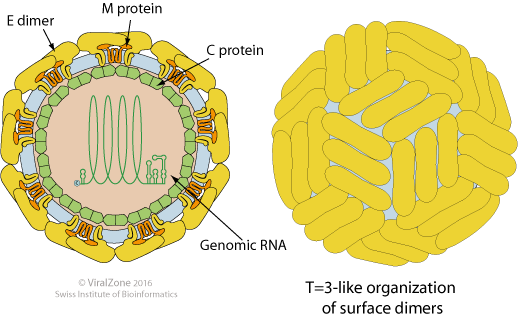Viruses are different from all the organisms that are dealt with in Biology.
They are described as acellular (not composed of cells) and are non-living.
This means that they do not carry out the normal day-to-day processes that living organisms do.
They do not function unless they are inside a living cell of a true biological organism.
Here they take over the cell's processes and use them to make more of themselves.
Virus particles - also known as virions - are built up from some of the same biochemical compounds that living organisms consist of.
These are extremely small and only visible using the electron microscope.
Viruses are not classified in the way that living organisms are. There is no viral Domain/Kingdom, but they may be categorised according to some of their characteristics.
The Baltimore classification - named after David Baltimore, not the place - clusters viruses into families depending on their type of genome.
Virus graphic images - all from ViralZone
Click on pictures for enlarged version (opens in separate window)
(Source: ViralZone www.expasy.org/viralzone, Swiss Institute of Bioinformatics)
The Ebola virus

The Zika virus

The adenovirus
 Note the stalked attachment proteins
Note the stalked attachment proteins
The herpes simplex virus
 This virus infects nerve cells in the face, including some near the lips, causing cold sores. HSV can remain inactive inside the body for years.
This virus infects nerve cells in the face, including some near the lips, causing cold sores. HSV can remain inactive inside the body for years.
The Influenza A virus
 On the surface of the influenza virus are several proteins, notably H and N antigens, of which there are many versions and combinations, e.g. H5N1.
On the surface of the influenza virus are several proteins, notably H and N antigens, of which there are many versions and combinations, e.g. H5N1.
Click to
see/ hide more information:
H stands for haemagglutinin, a glycoprotein responsible for binding the virus to sialic acid on the membranes of cell that is being infected, such as cells in the upper respiratory tract
N stands for neuraminidase, an enzyme that cleaves sialic acid groups from glycoproteins and it is required for influenza virus replication, enabling the virus to be released from the host cell.
Bacteriophage
 This virus infects bacterial cells. The tail fibres are responsible for the attachment of the virus particle to the host cell.
This virus infects bacterial cells. The tail fibres are responsible for the attachment of the virus particle to the host cell.
The structure of a virus particle

Virus particles consist of genetic material enclosed in a coat or capsid.
Genetic material
Virus particles contain either DNA or RNA.
This can be used to categorise viruses: DNA viruses, RNA viruses (riboviruses) or retroviruses.
Click to
see/ hide more information:
Many viruses contain DNA, just as most living organisms do. These can be divided into double-stranded and single stranded forms.
Double-stranded (ds) DNA viruses include:
Herpes simplex virus
Single-stranded (ss) DNA viruses include:
Protoparvovirus
Others contain RNA. RNA viruses can be divided into double-stranded, and positive and negative single stranded forms.
Double-stranded (ds) RNA viruses include:
Rotavirus - the most common cause of acute gastroenteritis in infants and young children worldwide
Bluetongue virus (BTV): causes bluetongue disease - a non-contagious, insect-borne, viral disease of ruminants, mainly sheep
Positive stranded ('sense strand') single-stranded RNA is capable of being directly translated into protein, in the same way that ordinary cellular messenger RNA operates.
Examples of positive-sense single-stranded RNA (ssRNA) viruses: poliovirus (picornavirus), Zika virus and
Coronaviruses: MERS, SARS, COVID-19
Negative stranded ('antisense strand') single-stranded RNA is not capable of being directly translated into protein, and has to be transcribed as soon as the virus enters the host in order to carry out viral replication. As a result, a viral-specific RNA polymerase is packaged in the virion, ready for transcription after virus entry.
Examples of negative-strand RNA viruses include influenza virus, measles viruses, rabies virus and Ebolavirus.
Retroviruses have genes encoded in RNA instead of DNA, and this needs to be reverse-transcribed into DNA by an enzyme called reverse transcriptase before it can be copied in the usual way. This is called retro in that it reverses the 'central dogma of molecular biology': DNA makes RNA makes protein.
Examples of retrovirus: HIV - human immunodeficiency virus - which has the potential to cause AIDS - Acquired Immune Deficiency Syndrome.
Other human retroviruses include HTLV-1 - the human T-cell lymphotropic virus 1, associated with certain T-cell leukaemias and lymphomas.
Click to hide the above.
Capsid
The outer coat of a virus is composed of protein. This is composed of sub-units called
capsomeres.
These assemble into geometic shapes. Many are polyhedral - with flat faces, making a regular hollow structure. The most common shape is an icosahedron (20 sides) but some are cylindrical/helical and bacteriophages have a tubular section as well as an icosahedral section.
Animal viruses may have an outer phospholipid-based layer: an envelope. This originates from a previous host cell: the outer plasma membrane or even intracellular membranes.
Attachment proteins
Many viruses have special attachment proteins projecting from their capsid or envelope. These bind to extracellular molecules on the surface of host cells, and assist the virus in attachment to and and entry specifically into the host cell (and in exit after infection).
Examples:
adenovirus (viral fibre glycoproteins)
influenza virus (haemagglutinin)
bacteriophage (tail fibres)
Serotypes
The proteins on the outer layer of a virus can trigger a response from the immune system of the infected organism. Different strains of virus can be distinguished by the presence of these proteins.
 This virus infects nerve cells in the face, including some near the lips, causing cold sores. HSV can remain inactive inside the body for years.
This virus infects nerve cells in the face, including some near the lips, causing cold sores. HSV can remain inactive inside the body for years.

